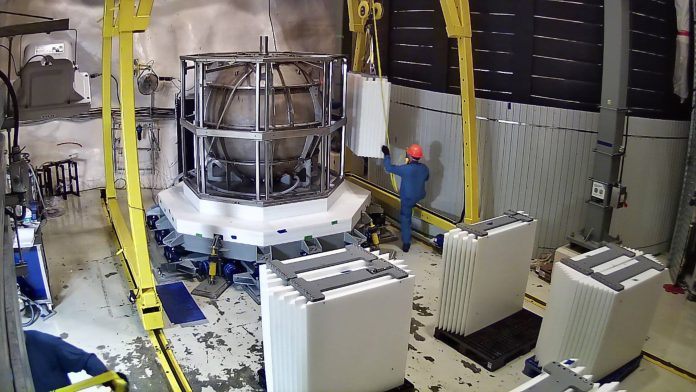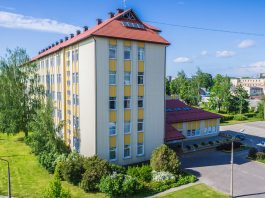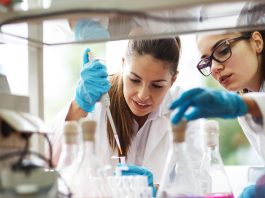The McDonald Institute is guiding Canada’s astroparticle physics research community, in collaboration with its international partners, to answer fundamental questions about the universe’s constituents.
The Arthur B. McDonald Canadian Astroparticle Physics Research Institute is Canada’s network for astroparticle physics research, uniting researchers, theorists, and technical experts within one organisation. Located at Queen’s University, the McDonald Institute has 13 partner universities and research institutes across the country, all of which are key players in Canada’s astroparticle physics community. The Institute is building new programmes to advance research co-operation between Canada’s academic researchers and their colleagues in the EU, US, Japan, and worldwide, striving to detect dark matter and determine the fundamental properties of neutrinos. These new programmes will contribute to the Institute’s work, which is supported by a generous $45.5m commitment from the Government of Canada.
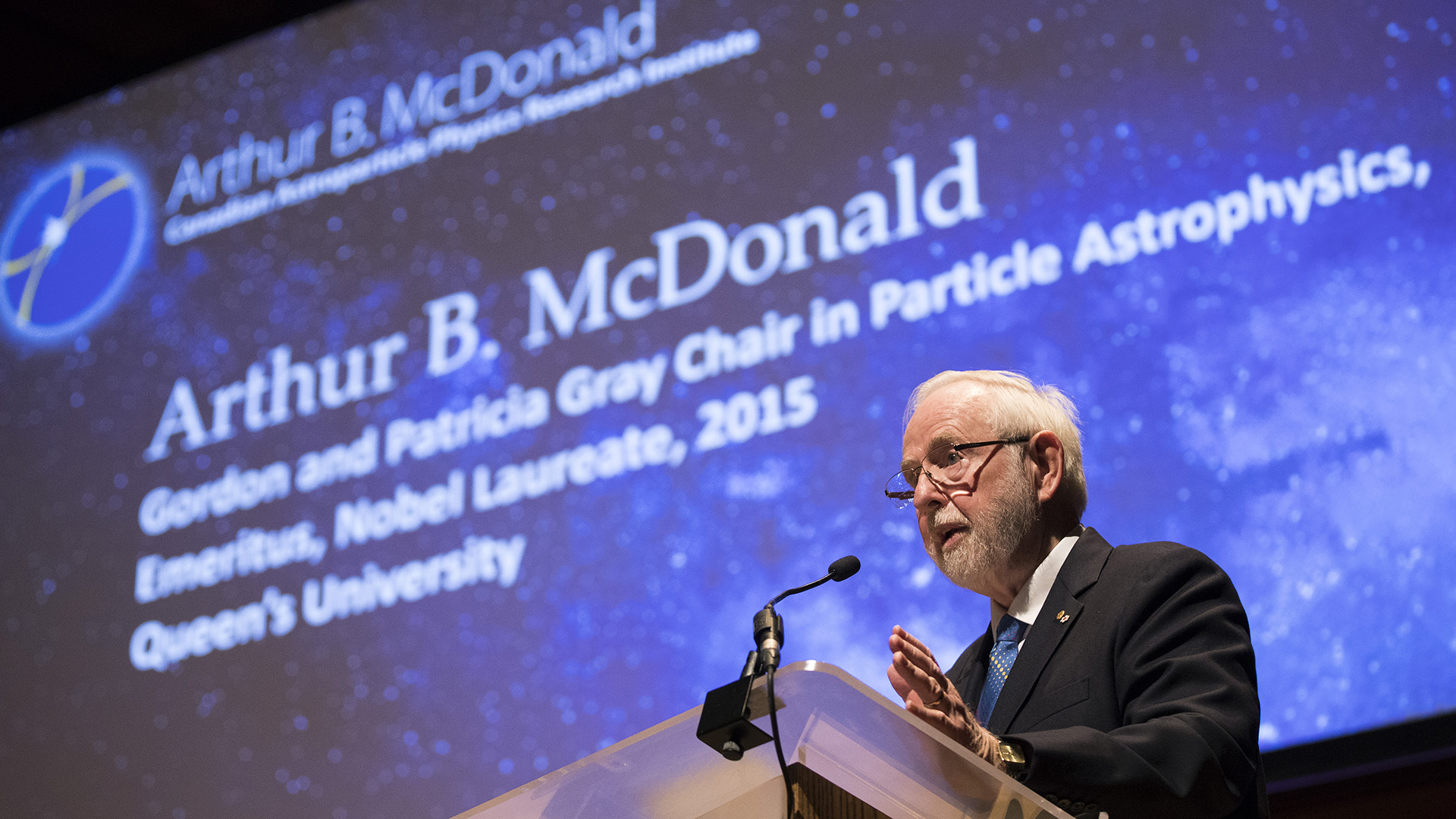
Driving astroparticle physics research
Dr Tony Noble, the Scientific Director of the McDonald Institute, said: “These are exciting times for the field. “Globally, astroparticle physics has rapidly expanded in the last decade, both as a way to broaden our toolkit for observing cosmological phenomena and as an optimal approach for testing some of physics’ most important theories about the particle composition of the universe.”
Canada hosts SNOLAB, the deepest, cleanest underground research facility in the world. Several cutting-edge instruments searching for elusive particle interactions, including dark matter, have recently been commissioned there, including experiments either led or co-developed by European partners, such as NEWS-G and SNO+. Experiments like SuperCDMS are in the process of installation and calibration.
As the fast-growing field’s international research collaborations expand and individual detector experiments approach decade-length durations, the Institute plays a key role in connecting the Canadian university research ecosystem with international collaborators. The Institute supports university-based researchers and engineers with a series of flexible programmes that advance the science while providing timely project support.
Dr Gilles Gerbier moved from Université Paris-Saclay to Queen’s University as a Canada Excellence in Research Chair in 2014 to oversee the completion and installation of the France-Canada led NEWS-G dark matter detector. He said: “The McDonald Institute’s work complements a facility like SNOLAB, making it easier to cultivate local academic research groups that can design, bench-test, troubleshoot and integrate key components for one-of-a-kind experimental prototypes. The Institute was able to expedite engineering resources at critical moments and facilitate exchanges of research fellows and students while providing them with a wide range of tailored professional development opportunities to help them succeed.”
Astroparticle physics
Astroparticle physicists study particles – often of cosmological origin – to develop and test theories about the nature of neutrinos, the origins of matter and antimatter asymmetry, and the elusive dark matter that physicists calculate must exist but whose existence has never been directly observed.
Frontier research over the past few decades has proven the field’s role in reshaping core scientific knowledge, including the standard model of particle physics that predicted a massless neutrino – which was disproved by separate Canada and Japan-based detector observations of solar neutrinos oscillating between electron, muon, and tau types – a major result that was honoured with a Nobel Prize in 2015.
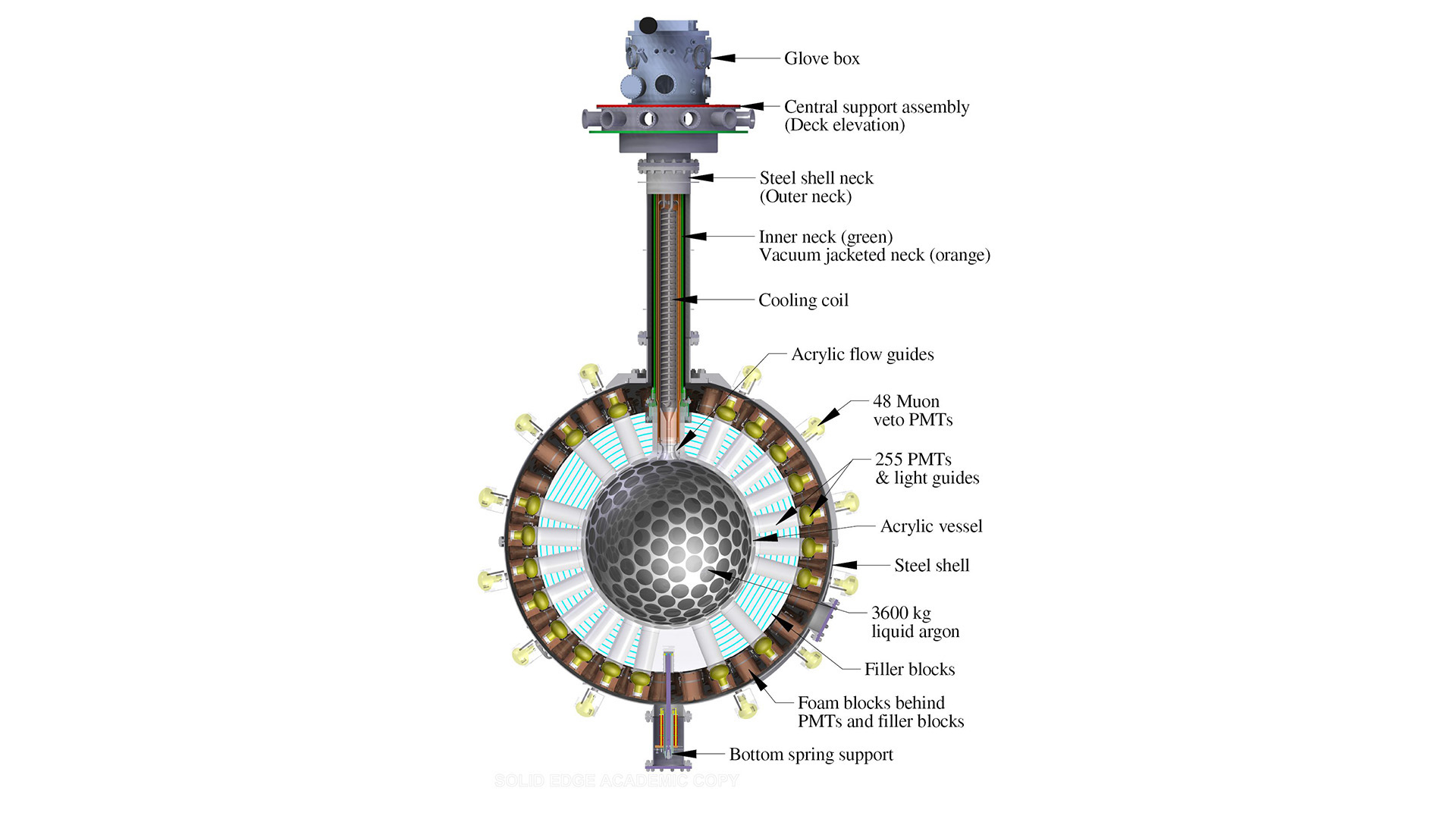
Working with Canadians
The McDonald Institute has facilitated university faculty, fellows, and students working on important collaborations, including NEWS-G, SNO+, SuperCDMS, and DEAP-3600 (an experiment that is part of the Global Argon Dark Matter Collaboration that includes DarkSide-20k currently under construction in Italy’s Laboratori Nazionali del Gran Sasso). It is also active in supporting proposed next-generation experiments under the nEXO, LEGEND, Pacific Ocean Neutrino Experiment (P-ONE), and Scintillating Bubble Chamber collaborations. The McDonald Institute has established a common-interest working partnership with AstroCeNT, Poland’s premiere astroparticle physics research centre, which is actively developing wavelength shifter and Silicon Photomultiplier technologies that will be used by the Global Argon Dark Matter Collaboration. Dr Marcin Kuźniak, an AstroCeNT professor, said: with Canada through the McDonald Institute expands our opportunities to design, build, and test the next generation of optical materials and single-photon detectors that are crucial for the work in our field. The McDonald Institute and other European partners have also co-applied with us for a €15m Horizon Europe ‘Teaming for Excellence’ call, with results expected this summer. The success of that initiative would elevate our partnership to an entirely new level.”
Apart from designing increasingly large and complex experiments, there is an art to progressing academics’ promising ideas from bench-scale prototypes to full-scale working experiments. Here, the McDonald Institute helps develop scientists’ ability to be creative in Big Science problem-solving.
“There are things you can plan for and things you can’t,” says Dr Jocelyn Monroe, a professor at the University of Oxford, who contributed to the DEAP-3600 detector located at SNOLAB. “The real talent of physicists is creative problem-solving of something that’s never been done before. Getting the resources together to support university researchers and engineering roles in such problem solving is a remarkable strength of the McDonald Institute.”
An important part of dealing with entirely novel problems is making sure you have responsive talent close at hand. Dr Noble explained: “One of the things we’ve done well at the Institute is responding to the rising needs of our colleagues working on projects important to Canada – whether it’s been supporting critical research fellows at key moments or finding engineers who can address experimental problems. We are expanding our capacity along these lines by increasing our pool of engineers and technical experts who are uniquely skilled in addressing the design and prototyping challenges typically encountered in very low background experiments in deep subsurface labs.”
Canadian creativity is a national point of pride in its contributions to the field. The Sudbury Neutrino Observatory (SNO), and later SNOLAB, were built 2km underground in a working nickel mine. SNO+, among the first large-scale neutrinoless double beta decay (0νββ) experiments, makes use of SNO’s original 10m acrylic scintillator vessel. Similar resourcefulness is seen in the P-ONE experiment, a proposed massive Cherenkov detector that uses very deep water as a medium for detecting high-energy neutrino interactions and plans to make use of the pre-existing seabed digital infrastructure operated by Ocean Networks Canada (ONC) off Canada’s western coast. Dr Darren Grant, a Canada Excellence Research Chair based at Simon Fraser University, explained: “Canada already had the infrastructure for the experiment – an underwater array for monitoring climate-induced changes to ocean currents and temperatures. Particle astrophysics was a new scientific direction for ONC, and over the past nearly ten years, a concerted effort has developed to explore the deep ocean site and ultimately realise a path to instrument it for high-energy neutrino detection.”
Noble said: “We certainly have been enthusiastic in supporting P-ONE researchers’ early validation work with timely support that extended that team’s ability to respond to unexpected challenges and opportunities. “The Institute’s mission is, ultimately, to get the most scientific advancement possible from the investments made by many partners.”
Common scientific questions
The McDonald Institute’s role as a talent-oriented facilitator of Canada’s contributions to astroparticle physics puts it in conversation with a broad range of international research. Key areas of common interest with its EU colleagues are:
Deep expertise
A key area of expertise in Canada concerns the design and operation of uniquely sensitive instruments in sub-surface environments with ultra-low background radiation. SNOLAB is the world’s premiere underground research facility. The 2km of rock above the lab filters most of the cosmic ray particles bombarding the surface of the earth from space. The entire facility operates as a Class-2000 clean lab with 5,000m² of space, providing an ideal site for a range of projects from tabletop prototypes to multi-tonne scale detectors.
Dr Monroe said: “Our field uses underground facilities all over the world to host experiments. “What Canada and SNOLAB offer is a specific scale and quality of low-background operating environments that can be critically important for certain kinds of experiments.” With a leading facility already established, the Institute’s role since 2016 has focused on expanding the number of university-based astroparticle physicists working in Canada and making it as easy as possible for them to engage their international colleagues’ work at home but also in the UK, EU, US, and Japan. Dr Monroe continued: “We’ve seen an enormous growth in the number of academic colleagues in Canada who can contribute to the most ambitious dark matter detection collaborations.”
Neutrinoless double beta decay (0νββ)
The idea that neutrinos could be their own antiparticle was first postulated by Ettore Majorana in 1937. If true, this would mean that two neutrinos in contact could co-annihilate each other like any other matter and antimatter pair. Such an event has never been observed but would have important scientific implications:
- It would determine the neutrino mass hierarchy, an unanswered question in physics that arose shortly after the Sudbury Neutrino Observatory and Kamiokande Detector collaborations won the Nobel Prize in 2015 for their joint discovery of neutrino oscillations
- It would contribute to the understanding of why the universe is made up of matter and not antimatter and why, during the Big Bang, there was an asymmetry of the two, allowing matter to persist and dominate the universe as we know it
- It would would be a huge step for future antimatter research
The SNO+ experiment is in its first phase of geo-neutrino observation (neutrinos emanating from the natural radioactivity of the Earth’s core) and is designed to eventually be loaded with material that could experience 0νββ decay. Other Canadian scientists are working with their EU and US colleagues on proposed 0νββ experiments like nEXO and LEGEND.
Dark matter
Theories of ‘invisible’ matter have been discussed since the early 20th century. Galaxy cluster behaviours, the rotation of galaxies, and other evidence support the notion that 85% of the matter in the universe cannot be seen or easily detected. A leading theory on the nature of this matter is that it is comprised of one or more Weakly Interacting Massive Particles (WIMPs) and, as such, should occasionally interact with ‘visible’ matter in a way that can be detected. Over the years, dark matter experimentalists have been able to put constraints on the range of possible WIMP properties. Future experiments will also look for low-mass non-WIMP dark matter candidates while larger-scale next-generation WIMP detectors are pursued through long-term multi-national partnerships. The McDonald Institute is engaged with a wide range of dark matter collaborations, including, but not limited to, NEWS-G, SuperCDMS, the Global Argon Dark Matter Collaboration, PICO, and the Scintillating Bubble Chamber.
High energy neutrinos & multi-messenger astronomy
As astrophysicists look deeper into space and more closely at nature’s largest-scale phenomena, astroparticle experiments can combine with electromagnetic and gravitational-wave detection to build a richer understanding of the universe’s workings. This ‘multi-messenger’ astronomy is a growing topic of interest in the field.
The IceCube Neutrino Observatory in Antarctica and KM3NeT’s pending ARCA detector in the Mediterranean Sea can detect uniquely high-energy neutrinos that emanate from the most violent cosmic phenomena and can also locate the direction of such particles’ origins. Often, these neutrinos arrive at nearly the same time as the electromagnetic or gravitational wave disturbances of such events, promising extended observational data for astronomers. The proposed P-ONE observatory in Western Canada would add to the amount of total sky coverage available for this kind of multi-messenger astronomy.
Theoretical physics
A unique cluster of astroparticle-focused theoretical physicists has emerged in Canada after the McDonald Institute expanded the numbers of university research faculty, fellows, and students working in the field thanks to the support of the Canada First Research Excellence Fund. This group is engaged with their experimentalist colleagues as well as their peers in high-energy particle physics, astrophysics, and cosmology – using observational data and experimental evidence to hypothesise and simulate the ways dark matter, neutrinos and the known fundamental particles could shape the evolution of the cosmos.
Dr Sarah Schön, an early member of this cluster and an Assistant Research Professor at Penn State University, uses astrophysical data to constrain the possible properties of dark matter. She said: “Successful modern physics research relies more and more on bringing together theorists, experimentalists, and observers, leveraging distinct perspectives and resources to push our understanding of physics and the Universe. The McDonald Institute, in conjunction with the Perimeter Institute and SNOLAB, creates a unique syzygy of approaches to astroparticle physics in one close-knit environment. There really is no substitute for exploring new ideas and building interdisciplinary collaborations than being able to talk to and learn from your fellow physicists on a regular basis. It’s an exciting place to do science.”
Addressing the challenges of long-duration, large-scale experimentation
Astroparticle physics plays the long game in frontier research, and it is one of Canada’s best implementations of long-duration, multinational knowledge work that increasingly dominates Big Science ambitions everywhere in the world.
The McDonald Institute values equity, diversity, and inclusion in astroparticle physics and contributes to co-developing and improving operational standards of practice for scientists that will sustain long-term research excellence. This work can help build a welcoming research community and make the best use of long-duration experiments as sites of global scientific diplomacy.
A highly skilled, adaptable, and internationally connected research community is an asset in itself. Scientific discovery aside, the ability to pivot and solve unexpected problems has tremendous value to Canada and the international community. During the COVID-19 pandemic, a team from Italy led by Dr Christiano Galbiati designed reliable mechanical ventilators that could be built quickly using readily available parts. Nobel Laureate Dr Arthur McDonald joined the effort and recruited SNOLAB, Canadian Nuclear Laboratories, TRIUMF, and the McDonald Institute into a Canadian arm of the Mechanical Ventilator Milano collaboration. Dr Galbiati said: “The Canadians were, of course, important design and engineering contributors to our collaboration. They were also extremely effective in collaborating with industrial and government partners to get 7,800 of the ventilators built in response to the pandemic threat.”
The McDonald Institute also dedicates funding for small, high-risk/high-reward, early-stage research and engineering projects and integrates the diverse and innovative research of university-based working groups within the broader research ecosystem, increasing connectivity, collaboration, and overall efficiency. This has come in the form of funding students, engineers, and postdocs to accelerate faculty projects and through extensive network-building activities within the community.
What’s next?
The Canadian research community has demonstrated world-leading science and reliable international collaboration and is ready for the next chapter. The McDonald Institute looks forward to the next 15 years of astroparticle physics research in Canada and plans for the next generation of large-scale, long-term projects, developing a critical mass of university-based researchers – a network of hundreds of scientists working in university labs, experimental facilities, and technology suppliers.
Stay connected with developments at the McDonald Institute through its monthly newsletter.
Please note, this article will also appear in the 18th edition of our quarterly publication.

